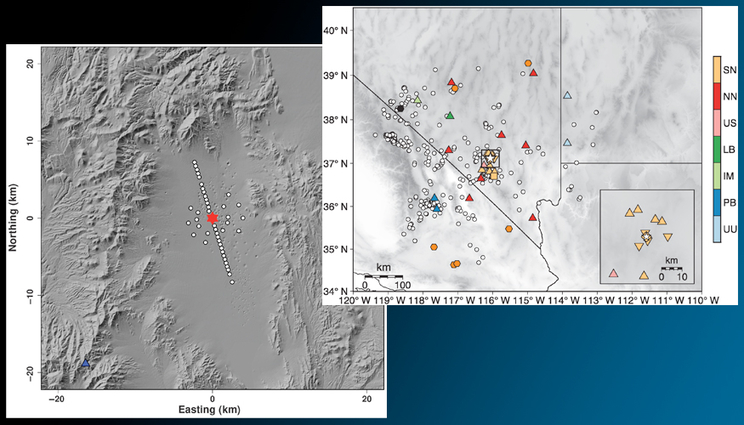Using seismoacoustics to improve explosion monitoring
 (Download Image)
(Download Image)
(left) The acoustic sensor network (white circles) and ground zero (red star) for the Large Surface Explosion Coupling Experiment at the Nevada National Security Site (NNSS). Researchers used data from this experiment to refine seismoacoustic models. (right) The network of stations at the NNSS used to build a data set and event catalogs for the development of new data processing algorithms.
In a special issue of the Bulletin of the Seismological Society of America, Lawrence Livermore scientists describe recent work in seismoacoustics, an area of research that uses observations of both seismic and low-frequency acoustic waves (infrasound) to differentiate between earthquakes and other shallow underground or surface sources like explosions and volcanoes.
Both geophysical hazards (volcanoes and earthquakes) and anthropogenic sources (chemical and nuclear explosions) release energy as mechanical waves (seismic and acoustic). As these waves move through the interfaces between the ground, ocean, and atmosphere, they pick up information about the media they traveled through. By analyzing these waves, researchers gather clues to help them identify the wave’s source location and characteristics, such as its type (geophysical or anthropogenic), yield, and depth. Livermore researchers are refining modeling efforts using joint seismoacoustic analysis to further reduce uncertainty in these event localization and characterization efforts.
In one study, Sean Ford and Oleg Vorobiev (both AEED) looked at the mechanism for acoustic wave generation transitions from gas-generated at the surface to spall-induced at depth. (Spall is the heaving of the surface due to the pressure wave from an explosion at depth interacting with the surface.) Although the two wave states are individually well described, the transition between the states is difficult to model due to the complex geomaterials beneath the surface. The team performed a numerical study using a Eulerian hydrocode that incorporated a variety of geomaterials with different strength and porosity. Their numerical predictions agreed with observations and recordings from experiments at the Nevada National Security Site (NNSS). Further numerical modeling of this type can improve seismoacoustic inference models for buried explosive yield.
In another study, Keehoon Kim and Michael Pasyanos (both AEED) evaluated the seismoacoustic yield technique by comparing two surface explosions at different times of day (early morning and afternoon) at the NNSS. Their analysis shows that the atmospheric boundary layer (ABL), which develops unstable stratification throughout the day, significantly affects acoustic wave generation and propagation. Without accounting for ABL variation near the ground, the yield estimation for acoustic signals alone had an unacceptably large uncertainty. However, when the team incorporated seismic data in their analysis, they found that the seismic and acoustic likelihoods effectively complemented each other, improving the accuracy of yield and depth and reducing the uncertainty of the estimates.
Further model testing, as well as the development of new data processing algorithms, is important for improving nuclear explosion monitoring capabilities. However, there are limited available data sets and event catalogs in explosion monitoring due to the difficulty in deploying physical sensing modalities. To address this gap, researchers from ENSCO, Inc. and Lawrence Livermore, Los Alamos, and Sandia national laboratories developed a data set of low-yield, low-magnitude events drawn from a buried chemical explosion conducted at the NNSS. The data includes records collected from seismic, acoustic, and electromagnetic stations deployed in multiple subnetworks, and the catalog includes various event types, including earthquakes, explosions, and unknown events, which have been localized mostly in Nevada and California. Future studies can leverage this dataset and catalog for testing and validating the methods for the detection, location, and characterization of seismoacoustic sources and for discriminating between earthquakes and explosions at local and regional distances.
[S.R. Ford and O.Y. Vorobiev, Numerical Modeling of Air‐Blast Suppression as a Function of Explosive‐Charge Burial Depth, BSSA (2023), doi: 10.1785/0120220231.]
[K. Kim and M.E. Pasyanos, Seismoacoustic Explosion Yield and Depth Estimation: Insights from the Large Surface Explosion Coupling Experiment, BSSA (2023), doi: 10.1785/0120220214.]
[R.L. Rodd, R.A. Brogan, J.D. Carmichael, A.C. Price, and C.J. Young, A Multimodal Event Catalog and Waveform Data Set That Supports Explosion Monitoring from Nevada, U.S.A., BSSA (2023), doi: 10.1785/0120220218.]
–Physical and Life Sciences Communications Team







